The Rockets’ Red Glare
Seeing double with View-Master’s "Huckleberry Hound Lands on the Moon"
Exploring the intersection of spaceflight history, pop culture, and space art.
This edition of Creating Space follows Huckleberry Hound as he attempts to launch into the heavens in a 1960 View-Master reel. Plus, we get a unique behind-the-scenes look at how Sawyer, Inc. manufactured their View-Master viewers and reels.
Are you new to Creating Space? It’s the NERDSletter that explores the intersection of spaceflight history, pop culture, and space art. You can find this and all other posts at creating-space.art.
Huckleberry Hound Lands on the Moon
What could be more fitting for Independence Day weekend than this fine specimen of vintage Americana?
This 1960 View-Master reel features Hanna-Barbera Production’s Huckleberry Hound, my generation’s blue dog with the southern drawl. In this single disk episode, containing seven stereo image pairs, Huck decides to embark (pun intended) on an explosive adventure. His intended destination: the Moon!

It is a fine example of the intersection of spaceflight history and exploration, space art, and science (rocket and stereo optics), and is firmly rooted in the pop culture worlds of television and toys.
Double Vision
My interest in stereo imaging goes way back to my childhood. I have previously shared with readers of Creating Space a 3-D lenticular image of an Apollo Lunar Module model, and more lenticular images will be coming in the future. One of my favorite toys I had when I was a kid – and even today – was my View-Master stereo viewer. This is that very viewer.
View-Master, originally made by Sawyer, Inc. of Portland, Oregon, (later acquired by GAF Corporation) was a plastic-age update to the antique stereo card viewers, also known as stereoscopes or stereopticons, that were popular in the late 1800s and early 1900s.1
Those vintage Victorian era stereoscopes consisted of a pair of lenses, separated about eye-distance apart, mounted on the front of a metal or wooden shaded visor and a long wooden plank (for lack of a better term) which supported a sliding holder for the stereo image cards. A wooden barrier extended some distance out from the lens plane and served to prevent the eyelines from crossing. Focus was achieved by sliding the mounted stereo card forward or back along the support plank.
Fancier models might have leather cushions on the face-side of the visor. And, often, there would be a wooden handle extruding from below.
The stereo cards, themselves, were approximately 7 inches wide (178 mm) by 3.3 inches (85 mm) tall. Each one had two photographs set side-by-side centered in front of each of the viewer’s lenses. Each photograph would have been taken from a slightly different vantage point, usually about 8 inches (20 cm) apart for far off subjects.2

Put the two together, look through the lenses, and the parallax effect presents you with a realistic (albeit sepia toned) three-dimensional view of the scene.
The ingenious innovations made by Harold Graves of Sawyer, Inc. and William Gruber, whose stereo camera rig gave Graves the idea, was to place multiple images on a single card and to provide a way to advance the images much as one could do with slide projectors of the time.
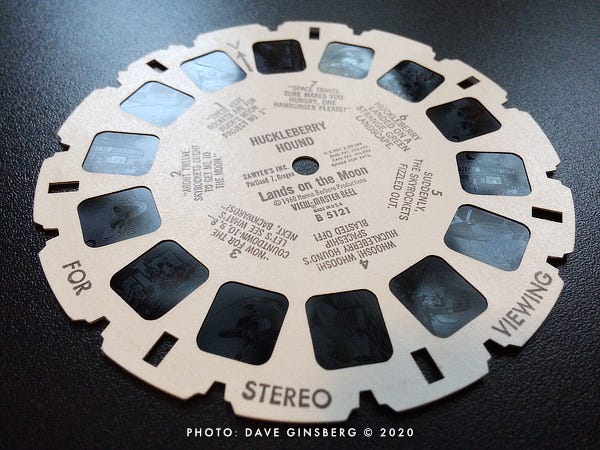
The stereo image pairs were printed on Kodachrome color transparency slide film and arranged around a 3.5 inch (about 9 cm) white cardboard disk. The disk is inserted into a slot in the top of the viewer. Notches on the edge of the disk align to the internal rotation mechanism, and the slide images are advanced using a spring-loaded lever on the side. A small window between the lens housings would reveal a short caption that was printed on the disk.
The pictured View-Master reel is the very same one I had when I was a kid growing up in the early days of manned space exploration. It is still in my collection.
The Reel’s Story
Huckleberry Hound’s lunar adventure begins much as that of the United States’ – with a bold choice to beat the Russians to the Moon. The text of the narrative booklet that came with the View-Master reel begins with Huck declaring, “I’m plumb fed up with them Russian fellas shouting about getting to the moon first. I guess it’s up to ol’ Huck Hound to do something about the situation.” Perhaps not quite as eloquent as John F. Kennedy’s “We choose to go to the Moon” speech in 1962, but arguably just as daring.
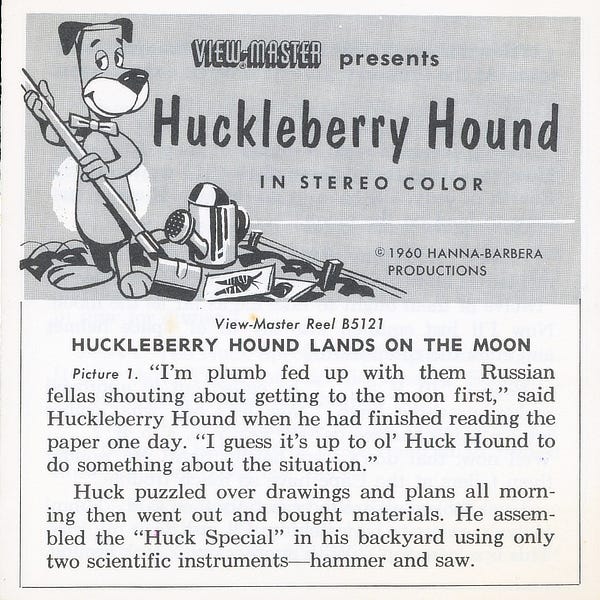
And, just like the U.S. space program in the early days, Huck had some previous, although mixed, success with rockets prior to committing to his Moon shot.
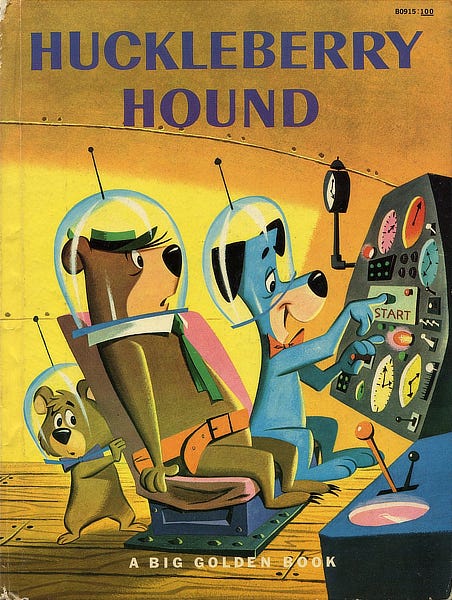
The View-Master reel I have originally came in a three-reel packet together with a Yogi Bear story called “Patron of the Arts” and another Huck story called “Project Green Thumb”. While I clearly feel a connection with Yogi’s art story, “Huckleberry Hound Lands on the Moon” is, of course, the one that really caught my eye.
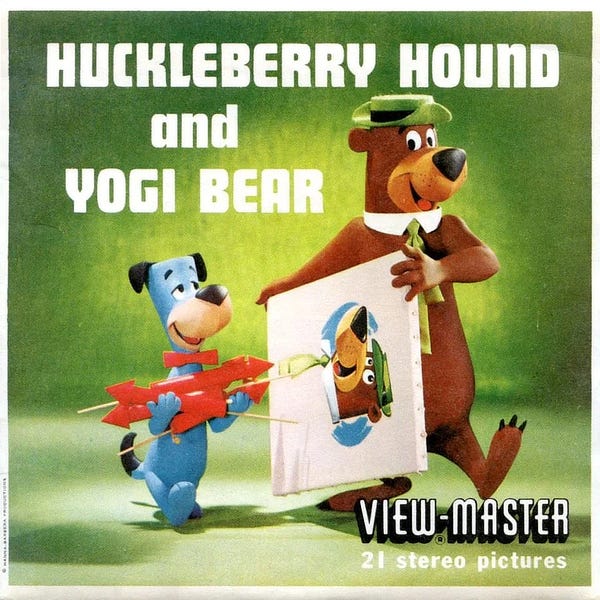
The success of Huck’s lunar mission rests upon the power of twelve sky rockets purchased from a local shop. He securely straps them onto the back of a home-made open cockpit (!) winged spaceship. With its streamlined construction and its carefully cut red and glittery silver paint job, his spaceship resembles the type you might find on a mechanical kiddie ride in front of the local grocery store in the 1960s.

Excitement ensues when the fireworks are lit and the rocket containing its bubble-helmeted pilot launches into the night sky. A clock tower is struck during the ascent through the atmosphere, and then Huck barely misses a pair of ducks just as his source of propulsive power poops out.

The sudden loss of lift causes a crash landing on a green and cratered apparently alien landscape. The final scene reveals that this was no alien planet at all, but a space-age 50’s drive-in with a domed roof made to look like the Moon. The final caption reads, “Space travel makes you hungry – a hamburger, please.”

For those with stereo viewers3, or that want to try their hand at free-viewing, here are stereo pairs of one of the frames from the View-Master disk. The first one is for parallel-eye viewing, or for use with stereo viewers.
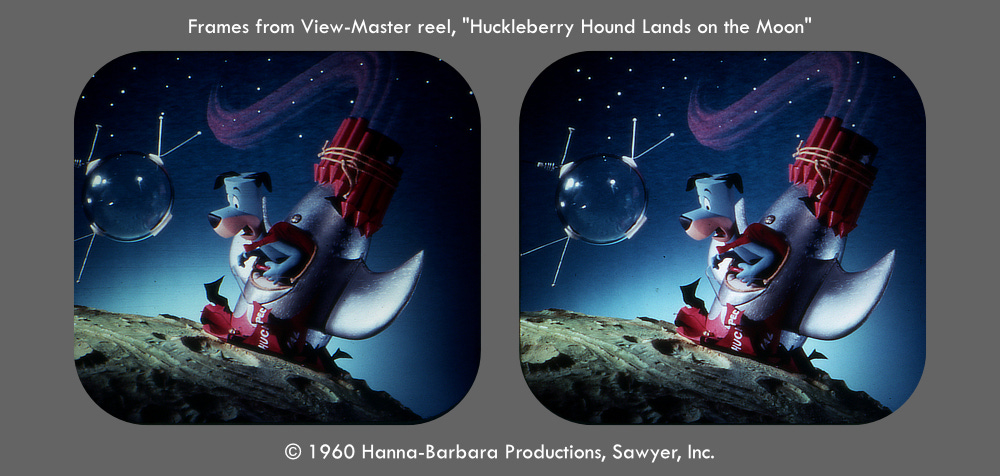
The second stereo image pair is for cross-eyed viewing. This may be easier for some than parallel viewing, which can take some practice.

Lasting Impressions
The images and the story of that adventure with its corny visual punchline have stuck with me from that time on. They were impressed upon the part of my brain that permanently records the things that I found wondrous as a child. They left a firm imprint on my developing psyche and served to help define who I would become as a person, an artist, an engineer, and a Space Geek.
When I first started to apply my 3-D computer modeling skills to creating space imagery, the scenes I made must surely have had a direct lineage back to my memories of View-Master reels like this one.
Compare my version of Planets to the fourth scene from the Huckleberry Hound reel. Even though I had not looked at that View-Master reel in decades, the influence is plainly visible.

What continues to impress me most about View-Master reels of this type is that everything you see in the frames is a real, physical object. It amazes me the amount of work that must have gone into their creation.
Someone expertly crafted the each one of the figures, models and every object that appears in the scenes. Everything was built by hand. No computer generated imagery, no Photoshop. Just models, fishing line, and perhaps a little bit of hand photo manipulation and clever double exposures. The artists peeled the two-dimensional cartoon characters off of their flat animation cells and transformed them into the three-dimensional physical world.
There is an excellent video showing what went into creating View-Master plastic viewers, three-dimensional scenes and stereo reels on the Cartoon Research blog edited by Jerry Beck. The live broadcast, called “Success Stories”, was sponsored by Richfield Oil Corporation and highlighted businesses in the Pacific Northwest region of the United States.4
Video: “Success Story”, Sawyer View-Master manufacturing, Portland, Oregon, ca. 1950s
About one minute into the broadcast we can clearly see some of the character and prop models used in the Huckleberry Hound and Yogi reels featured in this article.
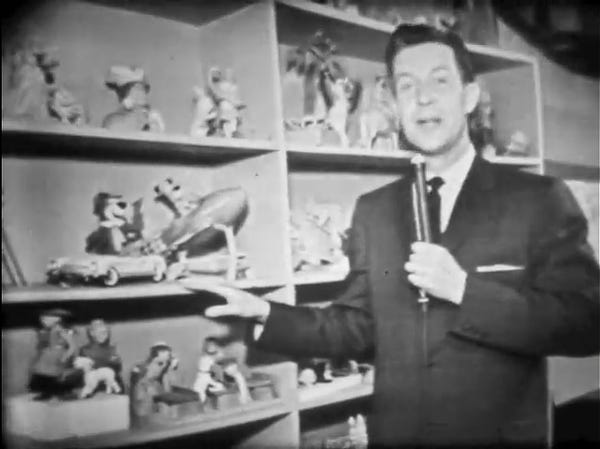
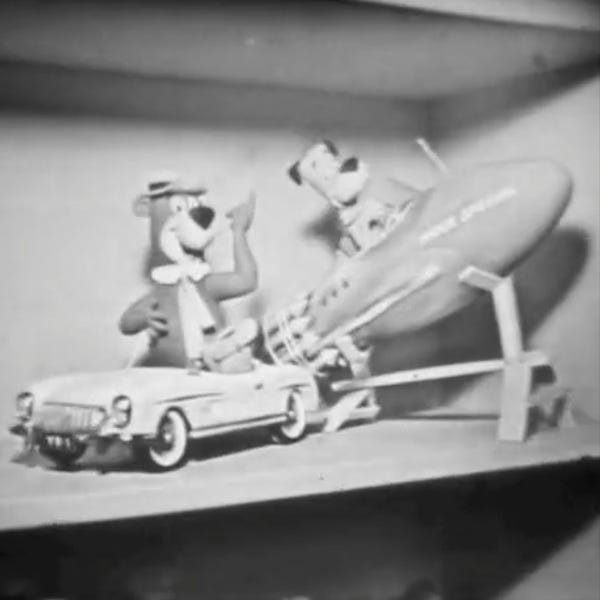
In creating some of my artwork, I make my own 3-D scenes and I sometimes create stereographic image pairs that work just like those on the View-Master reels. In contrast to the View-Master reels, nothing in my scenes is real. I model everything in the computer with a mesh of vertices, line segments, and faces. Color and texture are added with procedurally generated materials and bitmaps. Scenes are illuminated with imaginary lights and the resulting renderings are mere illusions of computational technology.
Again, here are stereo pairs of my ‘Planets’ artwork. The first one is for parallel-eye viewing, or for use with stereo viewers. The second stereo image pair is for cross-eyed viewing.
These days, so-called Artificial Intelligence (AI) tools can generate realistic images from mere text prompts in fractions of a second – including stereo images, as I just learned while researching this article. To be perfectly clear, I do not use such tools. My human hands, eyes, skill, and imagination are the only tools that I use to create my artwork. That’s the way it always has been for me, and likely will always remain so. I hope that, as a result, my humanity, heart, and humor come through loud and clear for viewers of my work.
When I gaze into stereo images, I get the same magical feeling that I experienced as a child. That sensation of being drawn into a three-dimensional world and being taken along on an adventure with a blue dog rocketing into the starry night.
Merch of the Month
Planets Signed Limited Edition Giclée Print
Signed Limited Edition Giclée prints are available directly from the artist.
My space-inspired art portfolio can be found at pixel-planet-pictures.com.
Do you know fellow Space Geeks who might enjoy Creating Space? Invite them into this space, too!
Did you miss a post? Catch up here.
If you enjoyed this article please hit the ‘Like’ button and feel free to comment.
All images and text copyright © Dave Ginsberg, unless otherwise noted. All rights reserved.
The Preservation Lab Blog, “The Stereoscope”, 2013
Brian May, London Stereoscopic Company, “How to Take Stereo Photographs”
OWL viewers, London Stereoscopic Company online shop
“Success Story” posted on Vimeo by Sci Fi Bob Ekman, via Cartoon Research blog edited by Jerry Beck





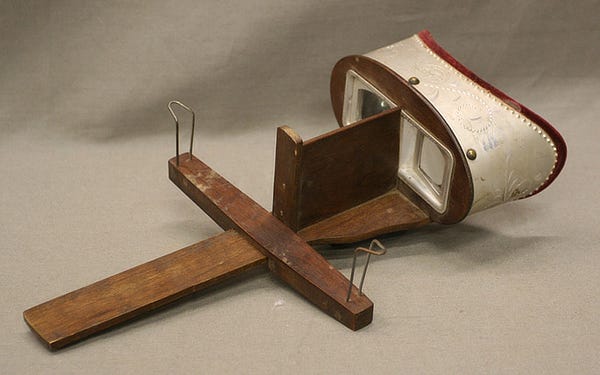

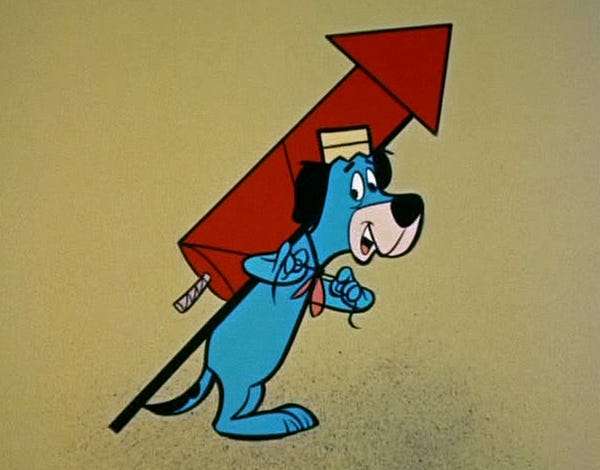
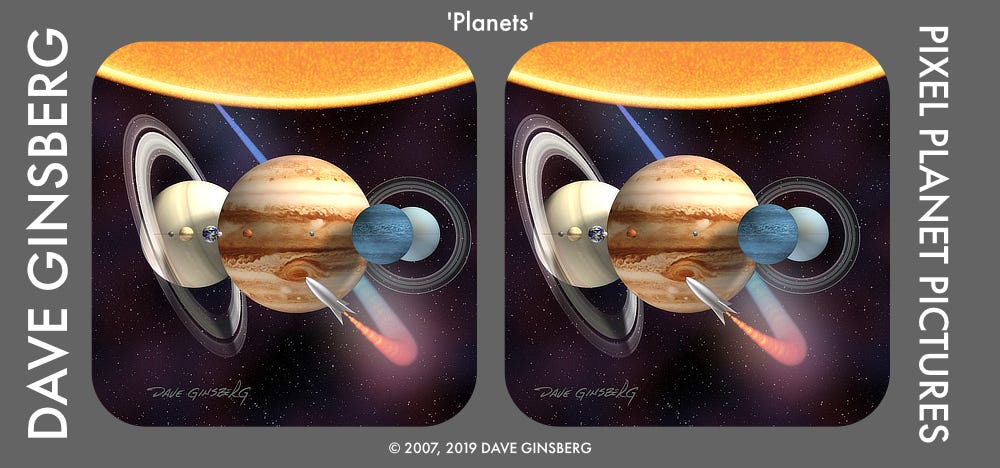
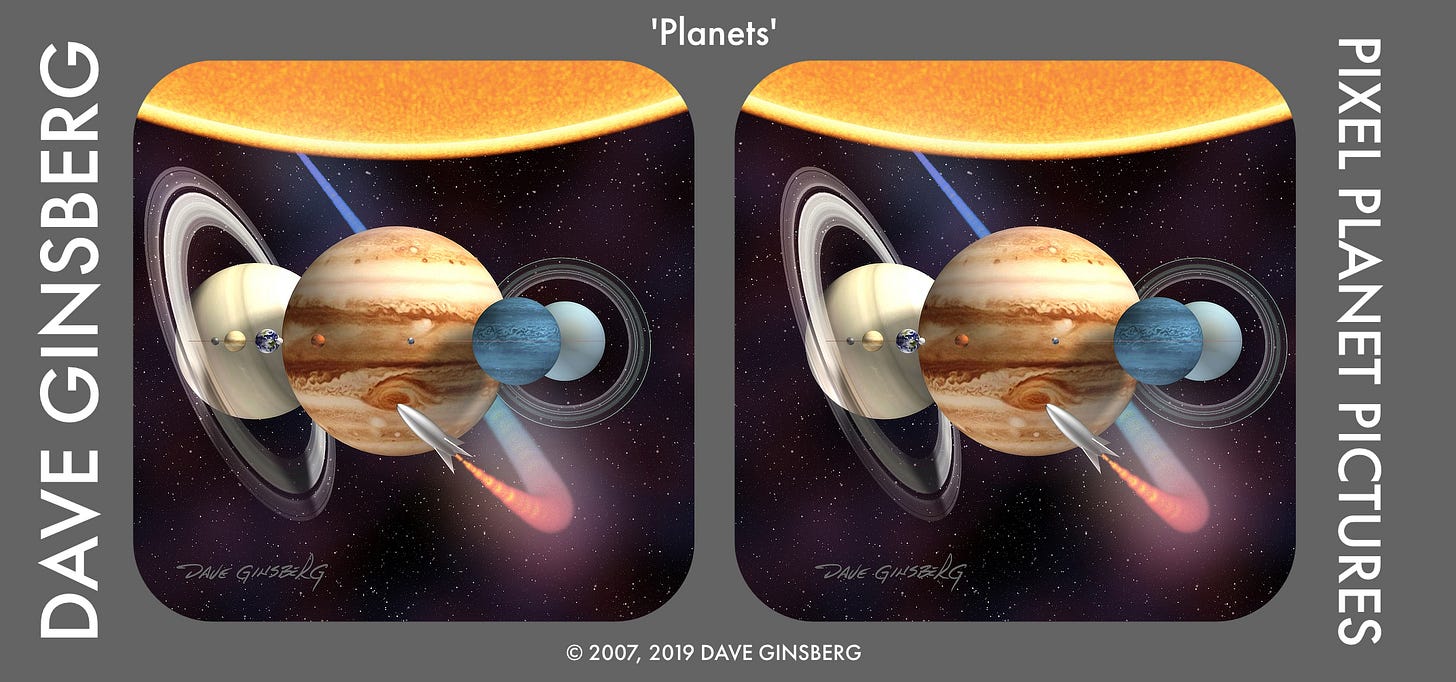






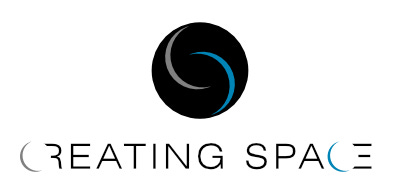
Another great story full of memories. Unfortunately I do not have the Huck View-Master slides but I do still have the View-Master viewer (which works quite well!) as well as some of the NASA View-Master slides like the MSC (Manned Spacecraft Center), the APOLLO 11 Moon Landing B 663 and Project APOLLO B 658. Use the https://viewmasterinfo.com/ browse link for their library. Search is currently not working. Oh yes, off topic ... yes I do have the Brady Bunch Grand Canyon and maybe the Hawai'i Vacation episodes also!
I had a viewmaster when I was about five?
Loved it, completely convincing 3d effect!